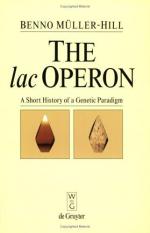|
This section contains 388 words (approx. 2 pages at 300 words per page) |
The Lac operon is an organized region of the genome that is present in the bacterium Escherchia coli. It is devoted to the metabolism of the sugar lactose (from which the lac designation arises). The lac operon is important in the history of genetics, representing the first transcriptionally regulated system to be elucidated. François Jacob and Jacques Lucien Monod discovered the operon's structure and mechanisms of action. Their work culminated in the 1965 Nobel Prize in physiology or medicine, which was shared with André Lwoff.
The breakdown and utilization of lactose by E. coli requires the activity of three enzymes--beta-galactosidase, lactose permease, and thiogalactosidase transacetylase. The genes encoding these enzymes are adjacent to each other on the E. coli genome. They are preceded by a region that is responsible for their regulation, depending upon the availability of lactose. Elsewhere in the genome are genes that encode products, which regulate the expression of the three vital lactose-metabolizing genes in response to the availability of another sugar, glucose. The collection and interactivity of all these genes comprises the lac operon.
When lactose is present, it acts as an inducer of the operon. Lactose enters the cell and binds to a protein called the lac repressor. This binding changes the shape of the repressor, causing it to detach from the region of the DNA where it was bound. The detachment allows transcription to occur, leading to the manufacture of the three proteins required for lactose metabolism. When the inducer (lactose) is removed, the repressor returns to its original configuration and binds to the DNA, so that the protein synthesis process can no longer occur. However, because transcription can commence as soon as the repressor detaches, the system is primed for action upon the addition of lactose. This mechanism provides the cell with a swift means of beginning lactose utilization once the sugar is available.
The expression of the lac operon is also under the control by another sugar, glucose. Low levels of glucose stimulate the formation of a molecule called cyclic AMP (cAMP). The cAMP binds to a site, which activates transcription. This phenomenon is called catabolite repression (glucose being a catabolite), a misnomer since it involves activation, but understandable since it seemed that the presence of glucose repressed all the other sugar metabolism operons.
|
This section contains 388 words (approx. 2 pages at 300 words per page) |


